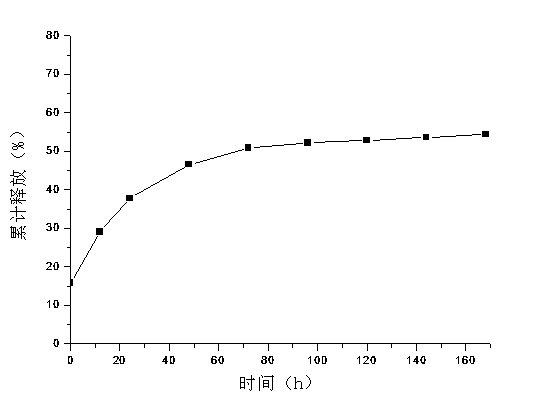Folate-polyethylene glycol-polylactic acid segmented copolymer micelle encapsulated with hydrophobic anticancer drug and preparation method of segmented copolymer micelle
A technology of block copolymer and polyethylene glycol, which can be used in anti-tumor drugs, drug combinations, pharmaceutical formulations, etc., can solve the problems such as no, and achieve the effects of good stability and good drug-carrying effect.
- Summary
- Abstract
- Description
- Claims
- Application Information
AI Technical Summary
Problems solved by technology
Method used
Image
Examples
Embodiment example 1
[0029] (1) Diaminopolyethylene glycol (NH 2 -PEG-NH 2 ) preparation
[0030] Dissolve 15g of polyethylene glycol-4000 in 50mL of dichloromethane solution, add 1.25g of triethylamine, dropwise add 7.5g of p-toluenesulfonyl chloride in 25mL of dichloromethane solution at 0°C, and react at room temperature for 6h. The solution was rotovaped and dropped into anhydrous ether. The crude product of polyethylene glycol-p-toluenesulfonate was obtained by suction filtration, and then excess p-toluenesulfonyl chloride was removed through repeated dissolution and precipitation, and dried in a vacuum oven for 48 hours to obtain polyethylene glycol-p-toluenesulfonate Pure.
[0031] Put 10 g of the obtained polyethylene glycol-p-toluenesulfonate pure product and 20 mL of ammonia water with a volume fraction of 25% in a pressure-resistant container, and react in a closed manner at 100 ° C for 8 h, cool to room temperature, and extract with dichloromethane. Sodium hydroxide was added to t...
Embodiment example 2
[0045] Preparation of folic acid-polyethylene glycol-polylactic acid block copolymer micelles encapsulating capecitabine:
[0046] (1) Diaminopolyethylene glycol (NH 2 -PEG-NH 2 ) preparation
[0047] Dissolve 20g of polyethylene glycol-4000 in 50mL of dichloromethane solution, add 1.54g of triethylamine, dropwise add 8g of p-toluenesulfonyl chloride in 23mL of dichloromethane solution at 2°C, and react at room temperature for 7h. The solution was rotovaped and dropped into anhydrous ether. The crude product of polyethylene glycol-p-toluenesulfonate was obtained by suction filtration, and the excess p-toluenesulfonyl chloride was removed through repeated dissolution and precipitation, and dried in a vacuum oven for 54 hours to obtain polyethylene glycol-p-toluenesulfonate Pure.
[0048] 10 g of the obtained polyethylene glycol-p-toluenesulfonate pure product and 17.5 mL of ammonia water with a volume fraction of 28% were placed in a pressure-resistant container, and the r...
Embodiment example 3
[0062] Preparation of folic acid-polyethylene glycol-polylactic acid block copolymer micelles encapsulating capecitabine:
[0063] (1) Diaminopolyethylene glycol (NH 2 -PEG-NH 2 ) preparation
[0064]Dissolve 25g of polyethylene glycol-4000 in 50mL of dichloromethane solution, add 1.786g of triethylamine, add dropwise 21mL of dichloromethane solution containing 8.33g of p-toluenesulfonyl chloride at 0°C, and react at room temperature for 8h . The solution was rotovaped and dropped into anhydrous ether. The crude product of polyethylene glycol-p-toluenesulfonate was obtained by suction filtration, and then excess p-toluenesulfonyl chloride was removed through repeated dissolution and precipitation, and dried in a vacuum oven for 60 hours to obtain polyethylene glycol-p-toluenesulfonate Pure.
[0065] Put 10 g of the obtained polyethylene glycol-p-toluenesulfonate pure product and 15 mL of ammonia water with a volume fraction of 30% in a pressure-resistant container, and r...
PUM
 Login to View More
Login to View More Abstract
Description
Claims
Application Information
 Login to View More
Login to View More - R&D Engineer
- R&D Manager
- IP Professional
- Industry Leading Data Capabilities
- Powerful AI technology
- Patent DNA Extraction
Browse by: Latest US Patents, China's latest patents, Technical Efficacy Thesaurus, Application Domain, Technology Topic, Popular Technical Reports.
© 2024 PatSnap. All rights reserved.Legal|Privacy policy|Modern Slavery Act Transparency Statement|Sitemap|About US| Contact US: help@patsnap.com








